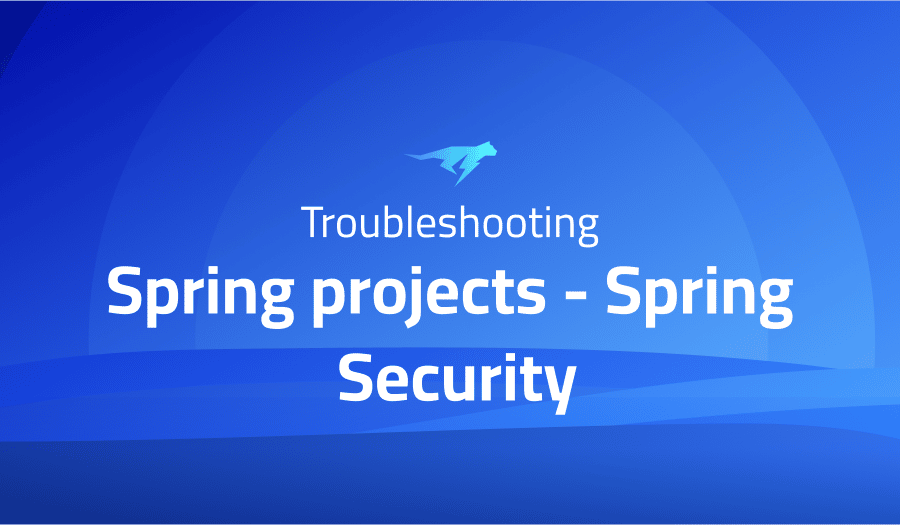

Troubleshooting Common Issues in Spring projects Spring Security
Project Description
Spring Security is a framework that provides authentication and authorization support for Java applications. It is a part of the larger Spring Framework, which is a widely used framework for building Java applications. It is designed to make it easy to add security to a Java application. It provides a number of features that make it easy to secure an application, including authentication, authorization, and secure communication. Spring Security offers a comprehensive suite of authentication and authorization capabilities, ranging from basic to advanced. Additionally, it supports secure communication via TLS or SSL for enhanced data protection. With these features in place, organizations can confidently protect their applications against malicious actors.
Spring Security is highly configurable and can be easily integrated with other Spring projects, such as Spring MVC, Spring Data, and Spring Boot. It is also compatible with a wide range of web servers, application servers, and databases.
Troubleshooting Spring projects Spring Security with the Lightrun Developer Observability Platform
Lightrun is a Developer Observability Platform, allowing developers to add telemetry to live applications in real-time, on-demand, and right from the IDE.
- Instantly add logs to, set metrics in, and take snapshots of live applications
- Insights delivered straight to your IDE or CLI
- Works where you do: dev, QA, staging, CI/CD, and production
Start for free today
The following issues are the most popular issues regarding this project:
Customize RestOperations / WebClient for OAuth 2.0
As stated in ClientRegistrations:
NOTE: The underlying HTTP Client used in
ClientRegistrationswas purposely encapsulated and there is no plan to expose it.
To ensure a comprehensive user experience, it is necessary to provide an option for users to customize the underlying HTTP client. This enhancement allows them to override the default configuration and configure their own personalized settings according to specific needs.
The following is the proposed enhancement for ClientRegistrations:
private static final Function<URI, Map<String, Object>> DEFAULT_METADATA_RESOLVER = (metadataEndpoint) -> {
RequestEntity<Void> request = RequestEntity.get(metadataEndpoint).build();
return rest.exchange(request, typeReference).getBody();
};
public static ClientRegistration.Builder fromOidcIssuerMetadata(String issuer, Function<URI, Map<String, Object>> metadataResolver) {
URI issuerUri = URI.create(issuer);
// @formatter:off
URI issuerEndpointUri = UriComponentsBuilder.fromUri(issuerUri)
.replacePath(issuerUri.getPath() + OIDC_METADATA_PATH)
.build(Collections.emptyMap());
// @formatter:on
return getBuilder(issuer, () -> {
// metadataResolver is either DEFAULT_METADATA_RESOLVER or a custom (provided) resolver
Map<String, Object> configuration = metadataResolver.apply(issuerEndpointUri);
OIDCProviderMetadata metadata = parse(configuration, OIDCProviderMetadata::parse);
ClientRegistration.Builder builder = withProviderConfiguration(metadata, issuerUri.toASCIIString())
.jwkSetUri(metadata.getJWKSetURI().toASCIIString());
if (metadata.getUserInfoEndpointURI() != null) {
builder.userInfoUri(metadata.getUserInfoEndpointURI().toASCIIString());
}
return builder;
});
}Spring Security is evaluating potential updates to the JwtDecoders and ReactiveJwtDecoders, which could facilitate a more secure experience.
OAuth2 Authorization Code redirect not working when using webflux.base-path
If you are using Spring Security with OAuth2 and are experiencing issues with the authorization code redirect not working when using the webflux.base-path property, it could be due to a couple of different issues. Here are some potential solutions to try:
- Make sure that the
webflux.base-pathproperty is correctly configured in your application. It should be set to the base path of your application, including the leading slash, but not including the context path. For example, if your application is deployed athttps://localhost:8080/myapp, thewebflux.base-pathproperty should be set to/myapp. - Make sure that the
AuthorizationRequestRepositoryyou are using is compatible with webflux. If you are using the defaultWebSessionAuthorizationRequestRepository, it should work with webflux. However, if you are using a customAuthorizationRequestRepositoryimplementation, it may not be compatible with webflux. In this case, you may need to create a customAuthorizationRequestRepositorythat is compatible with webflux. - Make sure that the
AuthorizationCodeGrantWebFilteris correctly configured. TheAuthorizationCodeGrantWebFilteris responsible for handling the authorization code grant flow in Spring Security OAuth2. Make sure that it is correctly configured in your application, and that it is configured to use the correctAuthorizationRequestRepository. - Make sure that the
RedirectServerWebExchangeMatcheris correctly configured. TheRedirectServerWebExchangeMatcheris used by theAuthorizationCodeGrantWebFilterto determine when to redirect the user to the authorization server. Make sure that it is correctly configured in your application, and that it is configured to use the correctAuthorizationRequestRepository. - Make sure that the authorization server you are using is correctly configured. The authorization server is responsible for handling the authorization code grant flow and issuing access tokens. Make sure that it is correctly configured and that it is able to correctly handle authorization code grant requests from your application.
More issues from Spring projects repos
Troubleshooting spring-projects-spring-boot | Troubleshooting spring-projects-spring-framework | Troubleshooting spring-projects-spring-data-jpa | Troubleshooting spring-projects-spring-data-rest
It’s Really not that Complicated.
You can actually understand what’s going on inside your live applications.




